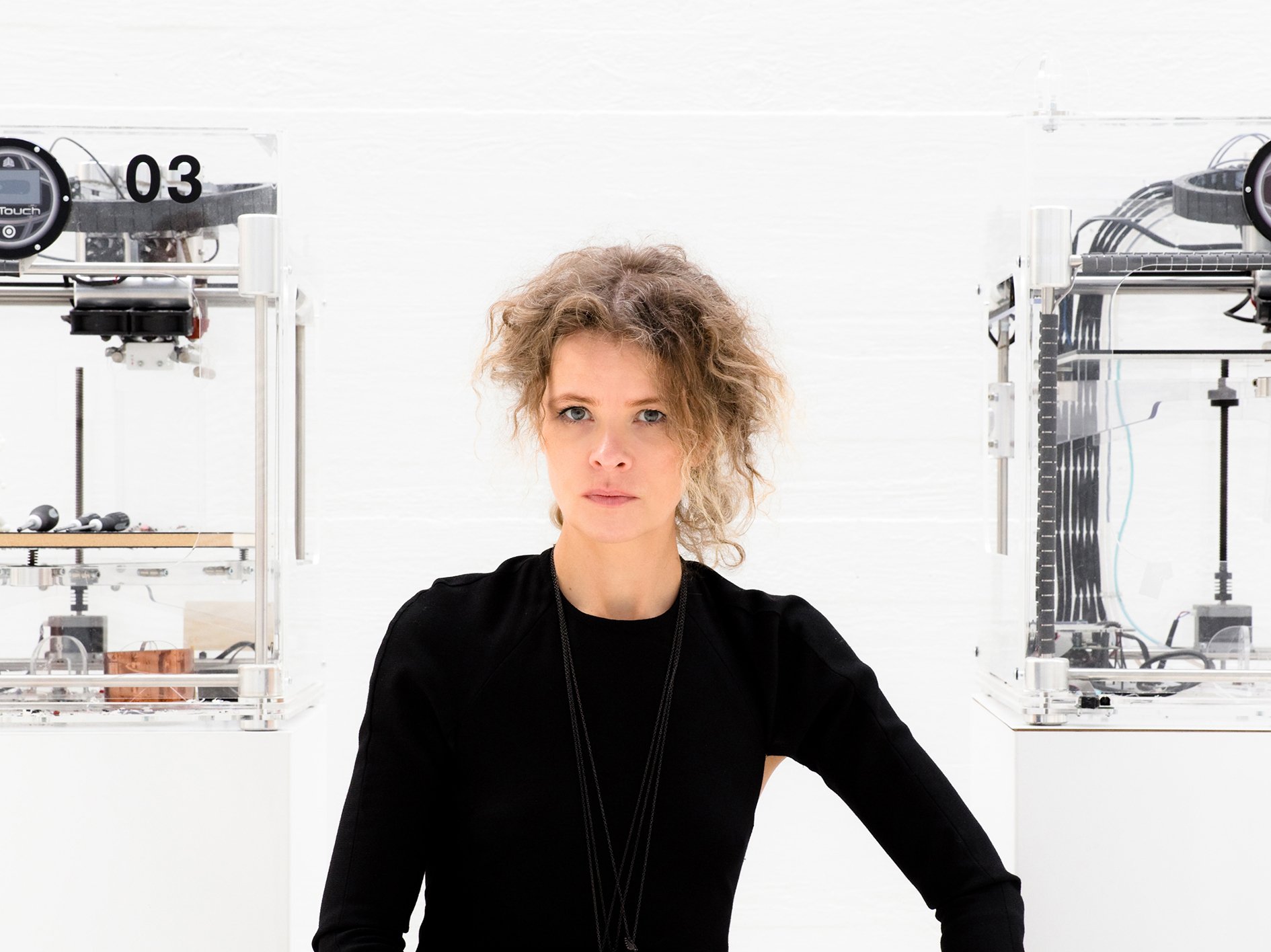
This article originates from Women In 3D Printing and is part of our effort to support the use of 3D printing technology by women. The article is re-published with permission.
Nora Toure: Katrin, could you let us know about your background and what brought you into 3D printing in the first place?
Katrin Olina: I am from Iceland and live between Reykjavik and Helsinki. I studied industrial design in Paris in the 90s and have in my carrier worked between product, graphic design, illustration and teaching. I came to 3D printing through philosophy, 2D drawing and the ultimate desire to materialize the subjective world and the existential ideas I was exploring. So I can say that it was quite a long, winding road that led me to 3D printing. When you are working with the conscious mind and the imagination, the material world can seem clumsy, almost prehistoric. I’ve worked with computers for over 23 years with the Adobe 2D programs. For most of my carrier, I explored 2D drawing as a mean to communicate my ideas, but when, a few years ago, I began to look into 3D printing, I saw that this technology was making complexity possible to realize in the material world.
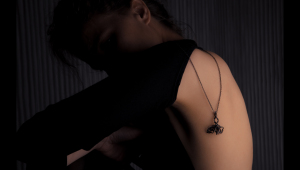
I saw the possibilities with my work and this is how my journey in 3D printing began. In late 2013, I spoke with creative director Kivi Sotamaa and director Jouni Partanen at Aalto Digital Design Laboratory in Helsinki and they welcomed me to develop my project there. I’ve been at ADD since as a guest researcher in the department of Mechanical Engineering.
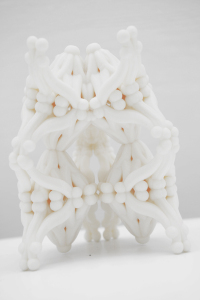
Nora Toure: Could you tell us more about your first experience with 3D printing?
Katrin Olina: When I came to ADD , I had been working with a single visual unit that I called the Primitiva in 2D graphic way. When I arrived at the laboratory in January 2014, it was to develop a 3D language of shapes based on this visual unit in combination with an exploration of philosophical ideas. I had never 3D printed anything before. I began to work with my visual unit in Autodesk Maya and 2 months into the process, when I was beginning to get a better handle on the structural language I was creating, we made the first 3D print. We printed a structure that measured around 20 x 15 x 12 cm. It was quite mind blowing to see it in 3D. I think that my background in product design and model making (I worked in the Philippe Starck Studio in Paris as well as in the Ross Lovegrove Studio in London after my graduation) in the past was very helpful to get into the third dimension digitally.
Nora Toure: What inspires you to create?
Katrin Olina: I create to remember and to connect with Self in the Universe. It is my way to learn and to further my understanding. It is a profound feeling that I can only describe as fundamental – my raison d’être. I am very interested in the mind, consciousness and communication. As a designer/artist, I work with that space between the immaterial and the material. That space between the psyche and the designed object or space interests me enormously. I have thought a great deal about what it is that brings some creations to life, that spirit that all artists hope to infuse their creations with. The alchemists of the past were pre-scientific and philosophical in their exploration of the material world through transformation and their ideas about transmutation. They sought ways to infuse matter with spirit. I like this notion and think that art and alchemy sometimes work in a similar way. It is that space between, that space of sprit/consciousness where transformation and communication happens. It’s a magical place.
Nora Toure: Why using 3D printing for your Primitiva Collection?
Katrin Olina: Serpentine lines from Hogarth’s The Analysis of Beauty
I’ve always used digital technology to create 2D drawings that I would then often scale up to large sizes and print for physical spaces such as interiors and exhibition spaces. When I came up with the Primitiva basic unit, it was in part based on a baroque theory of beauty by William Hogarth.
I took his serpentine line of beauty and created my own 3D version of it. It was a basic building block that I wanted to build objects with. 3D printing was clearly the most interesting path for the project. What is great about 3D printing and digital technology is the possibility of generating and to physically produce something that would be other wise next to impossible to make by hand. That is what technology should be used for, – to materialize dreams as well as to make our world more interesting and hopefully better.
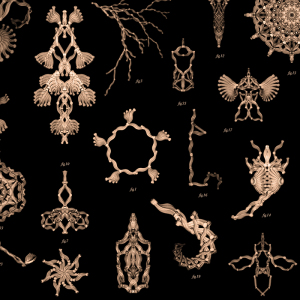
Nora Toure: How does the Aalto Digital Design Laboratory help you with the creation process?
Katrin Olina: It has been invaluable for me to be able to have space and both creative and technical support at ADD. We also teamed up with Kalevala Koru, Finland’s largest jewelry manufacturer to produce the 40 different prototypes of the Talismans in bronze. They have since become the production partner of the project. With my project we are mixing digital and traditional production methods by using the lost wax casting method for production of the pieces in bronze.
square
Nora Toure: What do you think of the 3D printing industry today? And how you like to see it evolve in the future?
Katrin Olina: There is a lot of progress, and it is happening fast. The big progress that is happening and is necessary for the industry to evolve is progress with materials and the processing and printing time. Ceramics is one interesting path and lots is happening with new materials and eco friendliness which is hugely important in my view. We are also seeing progress in terms of the computer programs and the printing. However, there are still many obstacles on the way from idea to 3D print. the computer processing is still complicated and slow although time wise things have sped up dramatically compared to a few years ago. This in my view will make the biggest difference in the future and make the technology more easy to use. When the printing becomes more of a seamless process then we will be able to do unbelievable things.
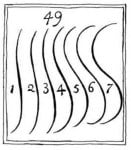
Nora Toure: In your opinion, how could we encourage more people to become involved with 3D printing?
Katrin Olina: That happens by showing the possibilities in a diversity of fields. When technology becomes more fluid and easy to use as a creative tool then the whole way of seeing and doing is altered. Still technical knowhow is required and quite many steps need to be made to print something out.
It is still as if the gap between the left and right brain of the process is too big. Many companies and startups are working on softwares that are making the creative to print process much more easy by developing programs that are more user friendly. These programs aim to simulate the physical way of modelling and to make the process of creating something more physical than clicking a mouse. I can´t wait to see how the future will look when the whole process of creation becomes more integrated and seamless. I think that the key to progress is to stop thinking about technology as separate from the creative process. The whole process needs to be interwoven. When this happens everyone will be able to create and print things out and this will change our reality dramatically!
If you are interested in learning more about Katrin and her work, we invite you to visit her collection here, as well as her Instagram and Facebook accounts.
And don’t forget to join the Women in 3D Printing group on LinkedIn and Facebook

